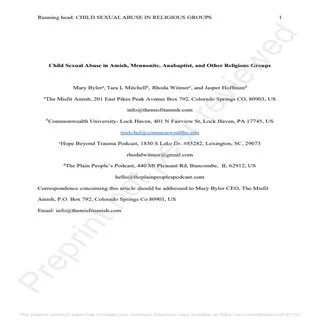By Mary Bylera , Tara L Mitchellb , Rhoda Witmerc , and Jasper Hoffmand
Background: Anabaptists are often stereotyped as quaint, conscientious objectors, peaceful, and gentle and are upheld as models for forgiveness, yet little is known about potential violence and abuse within their communities. Investigative reports, such as Espenshade and Alexander (2004) and Price (1992), though, suggest that sexual and physical violence may be common.
Objective: We sought participants for a study on their experiences of child sexual abuse (CSA). Because existing research on CSA has largely excluded Anabaptists or promoted the voices of their powerful over the marginalized voices of survivors, we intentionally sought current and non-practicing Anabaptist participants.
Methods: Participants (N = 384) responded to an online survey. Survey questions addressed participant demographics, religious affiliations, CSA experiences, and childhood teachings about CSA, as well as how CSA affected them.
Results: Of the 384 participants, 310 were born or joined in Anabaptist. Chi-square analyses showed that approximately half of participants experienced CSA, almost all participants were impacted by CSA, and CSA was related to changes in religious affiliation. Importantly, though, qualitative analysis revealed Anabaptist-background participants described CSA in ways that differed notably from participants not raised Anabaptist.
Conclusion: CSA occurs within conservative religious groups, including Anabaptist churches. Accurate information and language regarding bodies, abuse, consent, and resources could help conservative Anabaptist communities prevent CSA and provide culturally competent care for CSA survivors.
2024. 34p.


